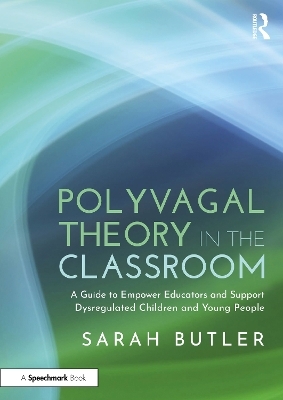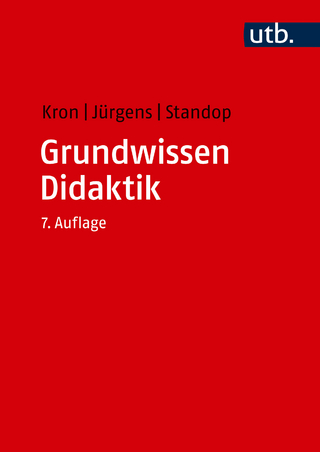
Polyvagal Theory in the Classroom
Routledge (Verlag)
978-1-032-50027-0 (ISBN)
Polyvagal Theory provides a breakdown of how the nervous system responds and reacts to unconscious messages of safety and threat. This accessible guide explores Polyvagal Theory and its potential for fully understanding and supporting the behaviours of children and young people in emotional distress at school.
By exploring how early childhood experiences - such as abuse, trauma, an insecure attachment, or bereavement - can have a detrimental impact on the development of the child’s nervous system, we can view their behaviours in a new light.
Polyvagal Theory in the Classroom:
- Contains a wealth of activities to use in the classroom
- Delves into new understandings of what is happening to children and young people when they become dysregulated
- Introduces practical ways to support pupils' emotional wellbeing, promote better mental health, and help to develop their capacity to self-regulate
- Contains exercises which provide opportunities for the reader to reflect on their own practice.
Packed full of case studies to bring theory to life, this book builds skills to gain awareness and control of our own nervous systems and to become the safe and calm presence for the overwhelmed child. This empowering book is essential reading for mainstream primary and secondary teachers, SENCOs and teaching support staff.
Sarah Butler is a child and adolescent therapist, offering bespoke guidance on therapeutic approaches to managing the behaviours of children who have experienced trauma, bereavement, abuse and/or insecure attachments. Sarah is also an experienced teacher, having worked in mainstream secondary schools and alternative provisions, including more than a decade teaching in a hospital school within an adolescent psychiatric unit, where she developed and delivered mental health awareness training to local schools and trainee teachers.
Introduction
Part 1: Understanding Polyvagal Theory
Chapter 1 - What is Polyvagal Theory?
Background
The Central Nervous System
The Autonomic Nervous System
The Evolution of the Brain
The Sympathetic Nervous System
The Parasympathetic Nervous System
The Vagus Nerve
Ventral Vagal Nerve
Dorsal Vagal Nerve
The Three Autonomic States
Blended States (Dual Activation)
Signs of Threat and Signs of Safety
Emotional Regulation
Summary
Chapter 2 – Polyvagal Theory and Child Development
Piaget – Cognitive Development Theory
Erikson – Psychosocial Development Theory
Vygotsky – Sociocultural Theory
Bowlby – Attachment Theory
Other Ideas about Child Development – Klein and Winnicott
Pulling The Ideas Together
Summary
Chapter 3 – Polyvagal Theory and Childhood Trauma
Defining Trauma
Early Trauma and Brain Development
The Biased ANS
Hormones
Connection – Protection
Summary
Chapter 4 – Seeing your pupils through the Lens of Polyvagal Theory
The Meaning of Behaviour
Self-Regulation, Co-regulation and Dysregulation
Impact of the Covid-19 Pandemic
Neurodevelopmental Conditions
Tracking Autonomic States
Renaming the Autonomic States
Summary
Chapter 5 – Getting to know your Autonomic Nervous System
ANS Tracking
Body and Breath
Regulation through Rhythm
Sensory Soothing
Mindful Moments
Brain workouts and Being your Best Friend
Calming Creativity
The Power of Pets
Summary
Chapter 6 – Calming the Dysregulated Child
Be Safe: Removing the threat
Feel Safe: Tuning in to your own ANS
Connect: Body Tracking, Breathing, Moving
Summary
Chapter 7 – A Whole School Approach
The Current Climate
School as a Container
Safety Starts at the Top
The Ventral Vagal Net
Transitions
Trauma-Informed, Attachment Aware, and other Approaches
Summary
Part 2: Using Polyvagal Theory with Pupils
1. Warm-ups
2. Creating a Safe Space – Boundary Setting
3. Psychoeducation
4. Self-awareness
5. Connecting to the Body
6. Connecting to Others
7. Self-soothing
8. The Connection Diet
Summary
Final Thoughts
Glossary
References
Index
| Erscheinungsdatum | 09.07.2024 |
|---|---|
| Zusatzinfo | 6 Tables, black and white; 13 Line drawings, black and white; 13 Illustrations, black and white |
| Verlagsort | London |
| Sprache | englisch |
| Maße | 174 x 246 mm |
| Gewicht | 300 g |
| Themenwelt | Sozialwissenschaften ► Pädagogik ► Didaktik |
| Sozialwissenschaften ► Pädagogik ► Schulpädagogik / Grundschule | |
| Sozialwissenschaften ► Pädagogik ► Schulpädagogik / Sekundarstufe I+II | |
| Sozialwissenschaften ► Pädagogik ► Sonder-, Heil- und Förderpädagogik | |
| ISBN-10 | 1-032-50027-1 / 1032500271 |
| ISBN-13 | 978-1-032-50027-0 / 9781032500270 |
| Zustand | Neuware |
| Informationen gemäß Produktsicherheitsverordnung (GPSR) | |
| Haben Sie eine Frage zum Produkt? |
aus dem Bereich


